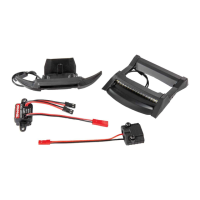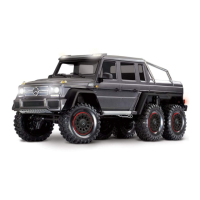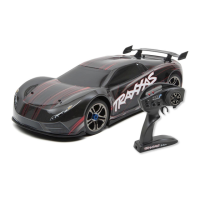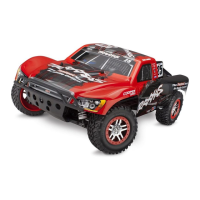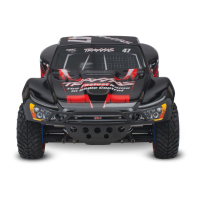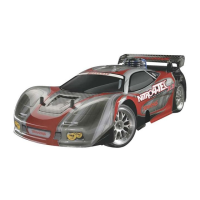Do you have a question about the Traxxas 67064-1 and is the answer not in the manual?
Traxxas technical support line and online resources for assistance.
Physical address, phone number, and website for Traxxas.
Key safety reminders for operating the RC model.
Precautions for using the electronic speed control (XL-5).
Critical safety warnings specific to LiPo battery usage.
General safety guidelines for charging and handling all battery types.
List of tools included with the model.
List of additional equipment needed to operate the model.
Optional tools and supplies that are useful for R/C hobbyists.
Instructions for applying model decals.
Definitions of key terms related to radio and power systems.
Crucial warnings for maintaining radio system performance and range.
Step-by-step guide to install batteries in the transmitter.
Instructions for charging the Traxxas NiMH battery pack.
Explanation of the Battery iD feature for automatic charger settings.
Instructions for installing the battery pack into the model.
Overview of transmitter controls and their functions.
Essential rules for safe and proper operation of the radio system.
How to adjust steering trim and reverse servo direction.
How to use the proportional reverse function on the throttle trigger.
Procedure to reverse the throttle channel on the transmitter.
Steps for checking radio system operation and model setup.
Procedure for testing radio system range before each use.
Tips for maintaining radio control at higher speeds and distances.
Steps to re-bind the transmitter and receiver if necessary.
Explanation of the Failsafe function and its operation.
Table of LED indicators on the transmitter and their meanings.
Table of LED indicators on the receiver and their meanings.
Detailed technical specifications for the XL-5 Electronic Speed Control.
How to configure Low-Voltage Detection for LiPo or NiMH batteries.
Steps to calibrate the ESC and transmitter for proper operation.
How to operate the speed control and understand its LED indicators.
How to select different speed control operating profiles (Sport, Race, Training).
Explanation of LED codes and protection modes for the ESC.
Factors affecting run time and battery life.
Strategies to maximize the run time of your model.
Guidelines and precautions for operating the model in wet conditions.
Steps to prepare the model before running in wet conditions.
Precautions for operating the motor in wet conditions.
Essential maintenance steps after operating the model in wet conditions.
Instructions for maintaining the receiver box watertight seal.
Procedure for removing and installing the receiver from the box.
Instructions for properly setting up the receiver antenna.
How to properly set the gear mesh for optimal performance.
Guidance on selecting shock mounting positions for different terrains.
Tips for fine-tuning shock absorbers using oil and pistons.
Procedure to re-center the steering servo.
Discussion on brushed vs. brushless motors and gearing.
Chart showing recommended gear combinations for the model.
How to adjust the slipper clutch for optimal power transfer.
Information on selecting and using aftermarket wheels and tires.
How to tune gear differentials by changing oil viscosity.
Steps to remove the front differential assembly.
Steps to remove the rear differential assembly.
Procedure for draining and refilling differential fluid.
Check for damage, binding, loose connections, and worn parts.
Periodic maintenance tasks for slipper clutch, chassis, steering, motor, and shocks.
Proper procedures for storing the model when not in use.
Instructions for removing front and rear suspension and slipper clutch assemblies.
The Traxxas Rustler 4X4 is a 1/10-scale electric stadium truck designed for high-speed action and off-road excitement. It comes equipped with a powerful Titan 12T 550 motor and a smooth XL-5 electronic speed control, making it a durable and long-lasting product for RC enthusiasts. The model features performance and appearance enhancements, including new wheels and tires with the latest tread patterns and rubber compounds for superb driving. Innovative technology, such as the patent-pending Torque-Control slipper, is also incorporated for enhanced performance.
The Rustler 4X4 is a radio-controlled vehicle that operates using a TQ 2.4GHz radio system. This system automatically locates and locks onto an available frequency, allowing multiple models to be raced together without frequency conflicts. The transmitter has two channels: one for steering and one for throttle control. The receiver inside the model has three output channels, with one servo for steering and an electronic speed control for throttle.
The electronic speed control (ESC) is a powerful device that delivers high current to the motor. It provides precise, digital proportional throttle control and uses power more efficiently than mechanical speed controls, resulting in longer battery run times. The ESC also includes circuitry to prevent loss of steering and throttle control as batteries lose their charge.
The model is capable of using both NiMH and LiPo batteries. The ESC features built-in Low-Voltage Detection, which monitors battery voltage. When LiPo battery voltage reaches its minimum recommended discharge threshold, the ESC limits power output to 50% throttle. If the voltage drops further, the ESC shuts down all motor output to prevent damage to the battery. For NiMH batteries, Low-Voltage Detection is typically disabled for best performance.
The Rustler 4X4 is designed with water-resistant features to protect its electronics, allowing it to be driven through puddles, wet grass, and snow. However, it is not fully submersible, and additional care and maintenance are required after wet conditions to prevent corrosion.
The model is designed for ease of use, with a Quick Start guide to get it up and running quickly. Before operation, users are advised to read the safety precautions, charge the battery pack, install batteries in the transmitter, and then install the charged battery pack in the model. The radio system should be turned on, and servo operation and range tested before driving.
The body of the Rustler 4X4 features an innovative latching system for easy removal and installation. To remove the body, the handle is turned 90 degrees counterclockwise to unlock the latch, then the latch is opened to release the body from the rear shock tower. The body then slides backward to release the front body tab.
The TQ 2.4GHz transmitter includes a steering trim knob to adjust the neutral point of the steering channel, ensuring the model drives straight when the steering wheel is centered. The radio system also has a Failsafe function that returns the throttle to its last saved neutral position in the event of a signal loss, preventing the model from running out of control.
The XL-5 electronic speed control offers different driving profiles:
These profiles can be selected through a simple programming procedure involving the EZ-Set button on the speed control. The ESC also includes Thermal Shutdown Protection, which automatically shuts down the unit if excessive temperature is detected, preventing damage.
Regular maintenance is crucial for keeping the Rustler 4X4 in top running condition. Users should periodically inspect the vehicle for damage or wear, checking for cracked or bent parts, binding in the wheels and steering, and proper operation of the shock absorbers. Wiring should be checked for fraying or loose connections, and the mounting of the receiver and servos should be secure. Wheel nuts should be tight, and the radio system's battery condition should be monitored.
The slipper clutch, built into the spur gear, regulates power to the wheels and can be adjusted. If the slipper clutch pads (friction material) wear down to 1.8mm or less, they should be replaced. Gear mesh should be checked and adjusted whenever a gear is replaced to prevent stripped spur gears.
The chassis should be kept clean of dirt and grime. The steering system components, such as bellcrank bushings and tie rod ends, may wear over time and should be replaced as needed to restore factory tolerances.
The Titan 12T motor requires lubrication every 10-15 runs. It should be removed, cleaned with an electric motor cleaning spray, and its bushings re-oiled with lightweight electric motor oil. The shocks should be kept full of 100% pure silicone shock oil to prolong seal life. If leakage occurs, the shock components may need to be rebuilt.
The driveline should be inspected for wear, such as worn drive yokes, dirty axle half shafts, or unusual noise. Components should be replaced if they pop apart. The spur and pinion gears should be checked for wear and tightness.
For wet conditions, additional maintenance is required. After running in wet conditions, tires should be drained, excess dirt and mud rinsed off the truck with low-pressure water, and the truck blown off with compressed air. Bearings, drivetrain, and fasteners should be sprayed with water-displacing oil. The sealed receiver box cover should be removed during storage to allow the air inside to dry, preventing long-term problems with sensitive electronics.
The front and rear gear differentials can be tuned by changing the oil viscosity. The differentials are sealed from the factory to maintain consistent performance, but for different driving conditions, users can change the oil to a lower or higher viscosity. The manual provides instructions for accessing and refilling the differentials.
When storing the model, the battery should always be disconnected and removed. If stored for a long time, batteries should also be removed from the transmitter.
| Product Name | Traxxas 67064-1 |
|---|---|
| Category | Motorized Toy Car |
| Scale | 1/10 |
| Motor | Velineon 3500 Brushless |
| Speed Control Type | VXL-3s |
| Drive Type | 4WD |
| Wheel Diameter | 2.8 inches (71 mm) |
| Chassis Structure/Material | Composite Nylon |
| Drive System | Shaft-Driven 4WD |
| Steering | Dual Bellcrank |
| Suspension | Independent |
| Length | 22.5 inches (571mm) |
| Width | 12.5 inches (318mm) |
| Radio System | TQi 2.4GHz |
| Battery | 7-cell NiMH or 2S/3S LiPo |
| Center Ground Clearance | 2.75 inches (70mm) |
| Gear Pitch | 32 |
| Top Speed | 60+ mph (96+ km/h) |
| Shock Type | Oil-Filled |


